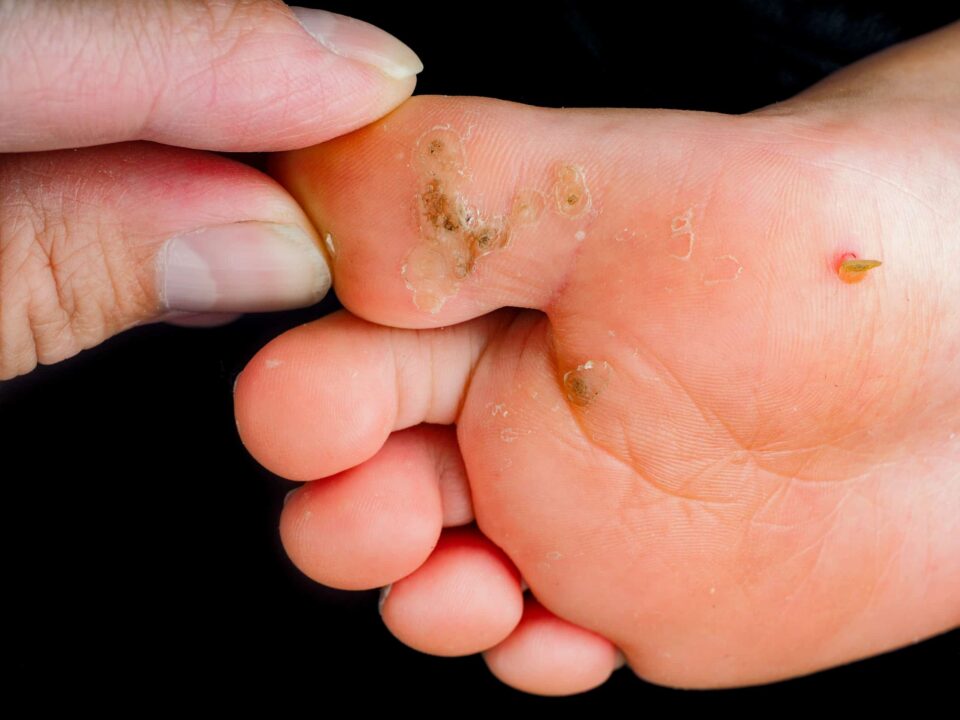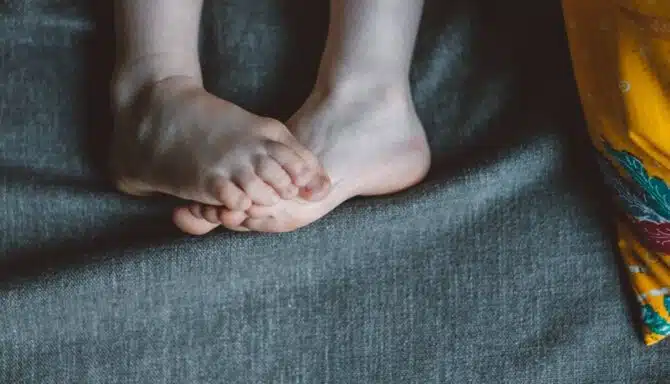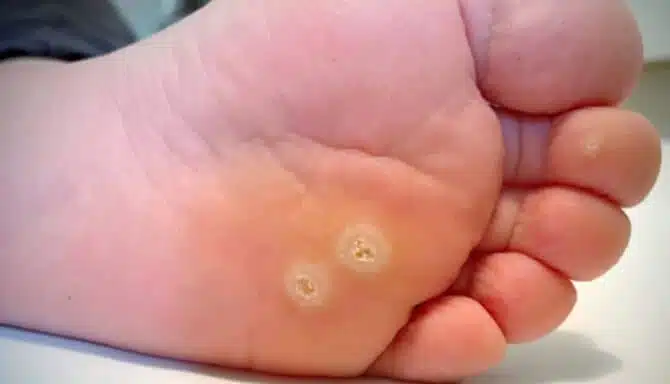January 30, 2023
As a parent, your children's health is a top priority. When it comes to their feet, it may be trickier to tell whether anything is wrong. Our feet are often covered; even then, certain conditions can be tricky to recognize.
Plantar warts can be a painful and unsightly problem, especially in children. But don't worry - you're not alone as a parent. Fortunately, plantar warts aren't severe. Most of the time, there is no cause for concern. Several effective treatment methods exist for children and teenagers, who are particularly susceptible to getting plantar warts.
Many types of warts exist. They can also target various parts of the body. Wart variations include common warts, flat warts, mosaic warts, filiform warts, and plantar warts. Warts on the feet are the focus of this article.
In this blog article, our medical team provides a complete guide for parents to recognize, prevent, and effectively treat plantar warts in children. With this guide, there's no need to let plantar warts interfere with your child's active lifestyle.
What are plantar warts?
Plantar warts are viral skin infections that grow on the feet's underside. HPV (human papillomavirus) causes plantar warts. HPV can infiltrate the body through skin contact, sometimes via a cut or break in the skin on foot. It's important to note that only certain types of HPV cause plantar warts. After all, there are 100+ types of the virus. (The HPV strain responsible for plantar warts differs from the HPV that targets the reproductive tract.)
Plantar warts get their name because of their location (plantar is another word for the sole of the foot).
The warts are small, flat, and hard circular growths. Plantar warts resemble a corn, callus or blister but may also contain tiny black spots. Bearing weight (like when you walk or run) adds pressure to the wart. The added pressure against the bottom of your foot causes the wart to grow inward. Thus, walking or standing on warts may also hurt. In response, your body builds a layer of skin on top of the wart to try to protect itself. This skin buildup resembles a callus.
Plantar warts are not a skin condition specific to the youth. Anyone can get plantar warts. They are not a severe health condition and may go away independently, especially in children under 12. However, they are contagious. It's best to treat plantar warts as soon as possible to prevent spreading to other body parts.
If left untreated, warts can last a few months to two years in children.
How do children get plantar warts?
Children get plantar warts by catching a specific type of HPV. The virus enters the body through direct contact between the skin and an infected surface. Since viruses thrive in warm, moist areas, shared spaces like spas, hot tubs, pools, or showers put children at risk.
Not everyone who catches the HPV strain gets plantar warts. Your immune system may be able to fend off the attack. If not, a plantar wart may surface.
Are children more likely to get plantar warts?
Yes, children and teenagers are more likely to get plantar warts than adults. According to the National Library of Medicine, various studies show that up to 33% of children and teenagers have warts. Between 3-5% of adults, by comparison, have warts.
Children and teenagers may be more likely to get plantar warts because of their environment. For instance, children and teenagers often use communal showers at pools or in locker rooms. If one child has a plantar wart, they may spread the virus to others. In some cases, children and teenagers may also get plantar warts due to a weakened immune system.
How can a parent help a child get rid of plantar warts?
A parent has several treatment options for their child if the child gets plantar warts. One is to allow plantar warts to go away on their own. Warts sometimes disappear in a few weeks or a few months on their own. During this period, parents should take precautions to avoid children spreading plantar warts to other body parts and people.
But warts can be uncomfortable (and aesthetically displeasing), and may persist or even spread and multiply. In these instances, a parent or child may desire more immediate action. Fortunately, that's doable.
A chiropodist or foot doctor can provide wart removal treatments. For children, parents may prefer less invasive treatment methods. We've ranked various treatment methods from less intrusive to more intrusive.
Prescription Topical Solutions
Cryotherapy
Cantharone/Cantharone Plus
Needling
Excision
How do I prevent my children from getting plantar warts?
The key as a parent is to limit your child's exposure to HPV when in shared spaces. Fortunately, there are many measures you can take.
Provide your child with sandals at school, the pool, or practice. Limiting their time barefoot in a locker room, a shower, or on deck at the pool can reduce their chances of catching HPV.
Encourage healthy foot hygiene. Use positive reinforcement and teach your child to keep their feet clean and dry.
Do not use instruments like pumice stones or nail files if previously used on a wart.
Inspect your child's feet. Minor cuts or cracks in the skin put your child at greater risk of catching the plantar wart-causing virus. Apply a bandage or waterproof plaster on the area to reduce their exposure
If your child partakes in activities requiring them to be barefoot, like gymnastics or dance, cover any warts with a bandage to preventspreading to other children.
September 15, 2022
Warts can occur anywhere on your body. These small, circular growths are a type of skin infection that stand out because of their roughness, slight discolouration, and sometimes pain. When it comes to your feet, the soles are a common place for warts. This skin condition is known as plantar warts.
Although warts on your feet are a common occurrence, this condition comes with very treatable solutions. From self-care remedies to visiting a foot specialist, the scale of treatment methods varies based on the persistence level of warts. If you're looking to avoid plantar warts altogether, learn about what causes them, or how to get rid of them, you've come to the right place.
In this article, we explore plantar warts, their causes, how to get rid of plantar warts, and finally how to book an appointment with a foot specialist if you have persistent plantar warts.
What are plantar warts?
Plantar warts are common viral skin infections that grow on the bottom of the feet. They are small, flat, and hard circular growths that look like a corn, callus or blister. Walking puts pressure on the wart, which makes it grow inward and builds a hard layer of skin overtop. Applying pressure to plantar warts (walking, standing, or running) may be uncomfortable, if not painful.
Anyone can get plantar warts: they are not a severe health condition and sometimes go away on their own. However, they are contagious. If they persist, they can grow, spread and cause foot pain when you stand or walk on them.
What causes plantar warts?
Human Papilloma Virus (HPV) causes foot warts by infecting the foot's outer layer of skin. HPVs are a group of more than 200 related viruses. In the case of plantar warts, the strain of HPV causing this foot condition is not severe and varies from the strain that infects the reproductive tract. If you think plantar warts and herpes or genital warts, are related, don't worry - the HPV strains are different.
Usually, the virus enters the skin through a perforation like a cut or small breaks in the skin. Frequenting high-traffic common areas like showers, change rooms, and pool decks increase your likelihood of contracting the HPV that causes warts because the virus can spread more easily in these areas. Understandably, the wart-causing virus thrives in warm, moist environments. (This can be said for several other foot conditions, actually, including athlete's foot.) Wearing Crocs or flip-flops will help lessen your chances of catching this virus by ensuring your bare feet do not come in contact with the virus.
Children and teenagers are more likely to get plantar warts because of their hobbies; additionally, those with weakened immune systems are at heightened risk. That said, like many foot conditions, anyone can get plantar warts.
So, what happens when you get plantar warts? Fortunately, there are several treatment options, including DIY methods as well as visiting a foot specialist.
Plantar warts treatments
Sometimes, plantar warts will treat themselves and go away with time. If that's not the case, a foot specialist like a chiropodist can easily remove plantar warts. There are also different treatments depending on how resistant the wart is to certain methods. For instance, if the wart is not responding to one treatment, a more aggressive treatment may be tried.
Regardless of the treatment method you choose, it's best to follow these practices:
Cover the wart to help prevent it from spreading to either other people or another part of your body
Wash your hands any time you touch the wart, accidentally or intentionally
Below you'll find a mix of at-home treatment methods and procedures done by a foot specialist at a local clinic:
Cryotherapy
Cryotherapy is a method by which extreme cold is used to freeze and remove a plantar wart. This procedure is quick and easy, and generally low risk. Instead of cryotherapy performed in a cold tank, this kind is slightly different and more concentrated. Cold therapy is performed via liquid nitrogen on a cotton swab. This treatment is performed every two weeks, and often requires several treatments to eradicate the wart.
Salicylic acid
Salicylic acid is a topical medication that is applied to the wart. It softens the skin and helps shed layers of skin (and the wart) bit by bit. It is found in many over-the-counter wart removal products, and a chiropodist can prescribe a high-strength salicylic acid topical solution that you can apply regularly at home. The higher the dose of salicylic acid, the better its treatment.
Laser treatment
Laser treatment involves cauterizing blood vessels. Ouch, that sounds intense. But, your medical practitioner will numb your skin first. To be effective, this treatment can be repeated every 2-4 weeks.
Blister-inducing medicine
View this post on Instagram
A post shared by Feet First Clinic (@feetfirstclinic_)
A foot specialist can help induce a blister under the wart by applying cantharidin, a type of burn agent. This is applied every 2 to 3 weeks by a chiropodist. The cantharidin forms a blister over the wart and separates the wart from the skin covering it and brings the wart to the surface. The blister then dries over the next few days and the wart falls off. The treatment is repeated until the wart is fully removed.
Needling
Needling is a simple, but more invasive wart removal procedure with roughly 70% effectiveness. After a local anesthetic is administered, a specialist punctures the wart with a sterile needle about 100 times. This method pushes the HPV away from the surface of the skin and internally where an immune reaction is triggered. If successful, your body's immune system will do the rest.
View this post on Instagram
A post shared by Feet First Clinic (@feetfirstclinic_)
Excision
Excision is used for plantar warts that resist other treatments. The foot is first numbed with a local anesthetic. Then, as the name implies, the wart is cut away (or “excised”) from the skin. The base is also cauterized to ensure no living viral tissue is left behind. There is a risk of scarring, so this method isn’t used unless other treatments have failed.
Duct tape
Duct tape is a common yet relatively unproven method for treating plantar warts (largely because plantar warts can disappear on their own, which makes it difficult to attribute to the treatment method). This DIY method relies on suffocating the plantar wart and stripping away the outer layer of the skin to help rid the virus.
July 16, 2021
Get out your swimsuits - it's time to go swimming! Indoor and outdoor swimming pools just reopened today in Toronto! Given that we are also in the warmth of summer, family pools are open and beaches and lakes are being swarmed by eager swimmers (and sun worshippers).
Swimming is not only a great family activity; it is also fantastic exercise - especially for people with joint and foot pain. It is one of the lowest impact forms of physical activity, which makes it accessible and suitable for people of all ages. Whether you're doing an aqua-fit class or laps around the pool, swimming is a fun and low-risk way to strengthen your joints and muscles, which is the best way to treat common foot conditions and foot pain, like arthritis, metatarsalgia and Morton's neuroma. And best of all, you can do it while enjoying the beautiful summer weather.
However, keeping your feet healthy when you go swimming, particularly in public pools, has many considerations. We are at a higher risk of contracting Plantar Warts, Athlete's Foot, and other fungal infections in public spaces. (Also consider chlorine's drying and irritating effects on your skin.) Keeping your hygiene practices is therefore crucial for healthy feet when swimming.
Below, we will give you the lowdown on common foot conditions that can affect you when you go swimming, and how you can treat and prevent them. We'll also give you some tips for good foot hygiene when you go swimming.
Plantar Warts
A plantar wart is a common viral skin infection. It presents as a small, rough growth on sole of the foot, and looks like a solid blister or small callus. They are usually caused by HPV, a virus carried by 2% of the population. The virus thrives in warm, moist environments, so a public pool is ideal for a plantar wart to grow - especially those wet puddles on deck and in the locker room. To protect yourself from getting plantar warts, it is wise to wear flip-flops or some other kind of footwear when you are in the locker room, on deck and in the showers (you don't need to wear them in the pool). If you already have plantar warts, wearing footwear in these places will also help prevent spreading the virus to other people.
Plantar warts usually affect children and teenagers more because they do more activities in high-risk places. However, healthy adults can contract them as well. Anyone immunocompromised is also more at risk.
If you do get plantar warts, our Chiropodists at Feet First Clinic can help you. We facilitate different treatments depending on the severity of the situation.
Athlete's Foot & Other Fungal Infections
Athlete's foot is a contagious fungal infection caused by dermatophytes. Sweaty feet from activity cultivates the growth of athlete's foot (hence the name). Fungal infections like athlete's foot thrive and reproduce in warm, moist environments. Thus they are very commonly found in public places like locker rooms or the pool deck, where there are lots of people walking around with sweaty, wet feet. If you or other visitors develop athlete's foot and go barefoot in these places, you risk transmitting it to others. In fact, fungal infections are much more contagious and difficult to treat than plantar warts.
To prevent or combat foot fungus, you need to enlist proper hygiene tactics. For starters, make sure you thoroughly wash your feet, ideally before and after swimming (between the toes too!). This will make your feet a less friendly environment for bacteria and fungal growth, and can help eliminate any newly acquired bacteria or fungus before it sets up shop on your feet.
It is also advisable to wear flip-flops or some other kind of lightweight footwear in locker rooms, showers and on the decks of public swimming pools. One idea would be to invest in a pair of swimming shoes. You can take these from the pool to the lake. They are also great if you are combing around rocky shores.
Click here for more information about how to avoid Athlete's Foot.
If you do acquire a fungal infection in your foot, you can visit our clinic and store to find the right anti-fungal treatment.
Foot Hygiene for Swimmers
Proper hygiene for your feet is the best way to deal with the threat of plantar warts or athlete's foot. You want to enjoy summer, and spend your time swimming, not dealing with foot issues.
The drying and irritating effects of chlorine on your skin is also something to consider. Dry feet can break up the skin in our feet and around our toenails. This provides a point of entry for fungal infections.
But don't worry; this is an easy fix. Below are our top tips for good foot hygiene when you go swimming:
Cleanse your feet regularly, and before and after swimming. Make sure you also get between the toes, where moisture can easily get trapped, and dry your feet thoroughly afterwards.
Use an anti-bacterial foot powder or medicated foot cream afterwards. We recommend Gehwol's Foot Powder: It has zinc-oxide, which has antimicrobial and skin protecting properties, as well as clotrimazole, which is proven to prevent fungal infections. You can dust some of this powder directly on your feet, in your socks, or in your shoes.
Moisturize your feet regularly, and especially after swimming. Our skin's natural protective properties are weakened when they're wet. Moisturizing strengthens them. For a one-size-fits all solution, try Gerlachs Gehwol Extra Universal Foot Cream. It thoroughly moisturizes and disinfects your feet. It can also help you with corns, calluses, and blisters.
Tend to your toenails and cuticles. The space on the sides of our toenails are a favoured entry point for fungal infections, so keeping it in tact is essential. We recommend Gehwol Fusskraft Soft Nail and Skin Protection Spray. It preserves the skin and nail's natural protective properties, and strengthens them. It also contains bisabolol and clotrimazole to help protect the skin and nails against fungal infection. It's so effective that the chiropodists use it in our clinic during treatments.
Treat yourself to a foot bath. After a day in the water, a foot bath intensely cleanses your feet (it also feels super nice!). For a refreshing foot bath that will also help fight foot odour and foot sweat, we recommend Gehwol Fusskraft Herbal Bath.
Keep Healthy Feet When Swimming
At Feet First, we love summer, and we are big fans of swimming. Public pools and their communities offer many opportunities for exercise and socialization for people of all ages and mobilities. By keeping your feet hygiene up and visiting us if you encounter any issues with plantar warts or foot fungus, we are here to help get you back in the pool! Call us today and book your appointment or learn more about the products we carry at 416.769.3338 (FEET.)





